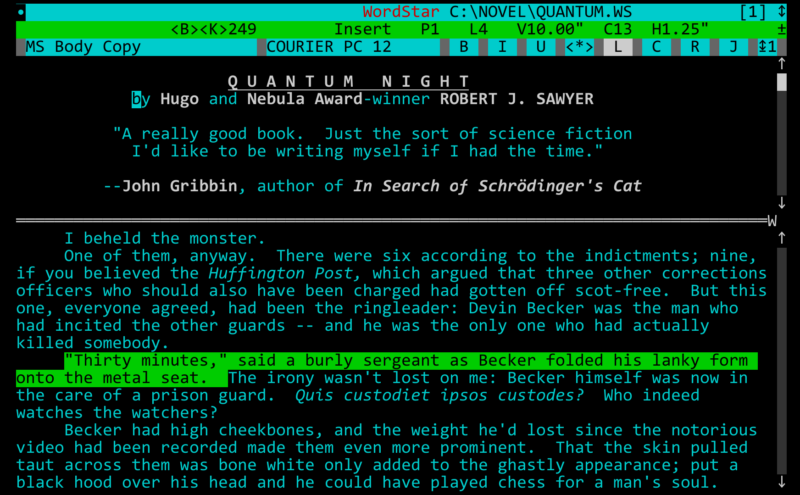
Robert J. Sawyer
WordStar’s most recent claim to fame might be that it’s the word processing application on which George R.R. Martin is still not finishing A Song of Ice and Fire.
But many writers loved and still love WordStar, a word processor notably good for actual writing. As computers moved on from DOS to Windows, and word programs grew to encompass features that strayed far from organizing words on a page, WordStar hung back, whether in DOS emulation or in the hearts of its die-hard fans.
One of those fans is Robert J. Sawyer, an award-winning science fiction author still using the program last updated in 1992. Deciding that the app is now “abandonware,” Sawyer recently put together as complete a version of WordStar 7 as might exist. He bundled together over 1,000 pages of scanned manuals that came with WordStar, related utilities, his own README guidance, ready-to-run versions of DOSBox-X and VDosPlus, and WordStar 7 Rev. D and posted them on his website as the “Complete WordStar 7.0 Archive.”
Why would Sawyer—and Michael Chabon and Anne Rice and Arthur C. Clarke and James Gunn—keep using a DOS program, decades past its last update, with quite a few workarounds needed for modern systems? Because it’s meant to help writers keep on writing. Like Vim or Emacs, it can be used with a system of keyboard commands entirely without a mouse; unlike Vim or Emacs, it is built for words and paragraphs, not code. Sawyer detailed this in an essay on his site, republished on Ars Technica in 2017. WordStar puts powerful commands near your strongest fingers and makes navigating text, bookmarking, and leaving unpublished notes for yourself far easier than WordPerfect, Word, or almost anything since.
As noted by The Register, Sawyer is also taking on the calculated risk of publicly declaring WordStar 7 abandoned. The program’s path from a CP/M app by MicroPro onward is winding, being shoved into a half-baked office suite, acquired by SoftKey, which became the Learning Company, acquired by Mattel, spun off to Houghton Mifflin Riverdeep, and is now the archival property of—well, nobody’s quite sure. The history of WordMaster, WordStar, NewWord, and their offshoots and intermixing is fascinating, with a hospital bedside power-grab, lawsuits, and names like Corel and Xoom you haven’t heard in some time.
The full package
If you download the entire 700-ish MB package, you can see all of this for yourself. Sawyer’s README (included in full on the archive page) details the tweaks he recommends for getting WordStar running in DOSBox-X, like setting the screen to 80 columns and 25 lines of text, picking a good font, and switching CapsLock and Ctrl keys to make use of WordStar’s home-row-oriented shortcuts. There’s even a utility for converting WordStar files to something Word or other modern tools can read, handily named CONVERT.EXE.
I wasn’t able to get WordStar working on Windows, Mac, or Linux; it would boot, but it would complain that it “Can’t find C:WSDSPCH.OVR” and shut down soon after, even when I would cravenly mount and provide DOSBox with full access to my root Windows drive. But I’m a relative newcomer to DOSBox-X, so I’m sure it’s something quite simple—yet profound.
